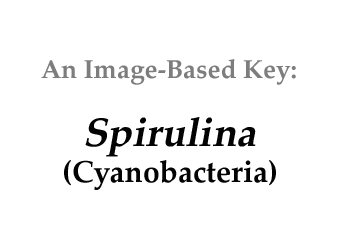|
Home / Cyanobacteria / Filaments / Unbranched / Untapered / No_heterocysts / No_visible_sheath / Spirulina |
||||
|
|
||||
 |
 |
 |
 |
 |
|
|
|
|||
|
Click on images for larger format |
||||
Name derivation: |
||||
Classification: |
||||
Spirulina Turpin ex Gomont 1892; 65 of 106 species descriptions are currently recognized taxonomically (Guiry and Guiry 2013).Order Oscillatoriales; Family PhormidiaceaeSynonym Arthrospira Sitzenberger ex Gomont 1892 (Geitler 1932). |
||||
Morphology: |
||||
|
Helical trichome with variable coils from tight to loose. Variable cell length and width (at least 2 - 20 µm) and length/width ratio (at least 0.1 - 10). In some species it is difficult to see crosswalls with standard light microscopy, but they can be demonstrated with electron microscopy. |
||||
Similar genera: |
||||
|
|
||||
Habitat: |
||||
|
Various species are freshwater, brackish water, marine, and mineral springs. Several species are benthic in freshwater. Others are planktonic in saline lakes of California and Mexico. Some species are cultivated to be sold as health supplements, usually under the name Spirulina platensis .
|
||||
|
Use in food supplements |
||||
|
Cyanobacteria intake as a 'health food supplement' is voluntary, mostly for its rich protein content (e.g., Spirulina, Nostoc, and Aphanizomenon flos-aquae). ‘Blue green algae’ [sic] supplements (BGAS) are mainly sold in industrialized countries, thought to have beneficial health effects such as detoxification, weight loss, elevated mood and energy, and increased alertness. Furthermore, some of these products are used in the pharmacological therapy of Attention Deficit Hyperactivity Disorder (ADHD) in children. Several independent investigations reported high MC levels in BGAS products, sometimes even higher than the provisional guidance value of 1 μg g-1 d. w. set by the Oregon Health Division and Oregon Department of Agriculture (Drobac et al. 2013). There is a danger that some of these supplements contain cyanotoxins capable of inducing liver and neural dysfunction even to the point of death.
|
||||
References: |
||||
|
Drobac, D., N. Tokodi, J Simeunovic, V. Baltic, D. Stanic, and Z. Svircev 2013. Human exposure to cyanotoxins and their effects on health. Arh Hig Rada Toksikol 64:305-316. Gomont, M. 1892 '1893'. Monographie des Oscillariées (Nostocacées homocystées). Annales des Sciences Naturelles, Botanique, Series 7 16: 91-264, Plates 1-7. Geitler, L. 1932. Cyanophyceae von Europa (1196 pp). In: Rabenhorst, L. (Ed.). Kryptogamen-Flora von Deutschland, Osterreich und der Schweiz. Akademische Verlagsgesellschaft m. b. H. Leipzig. Guiry, M.D. and G.M. Guiry 2013. AlgaeBase. World-wide electronic publication, National University of Ireland, Galway. http://www.algaebase.org; searched on 04 September 2013. |
||||
|
Home / Cyanobacteria / Filaments / Unbranched / Untapered / No_heterocysts / No_visible_sheath / Spirulina |
||||












